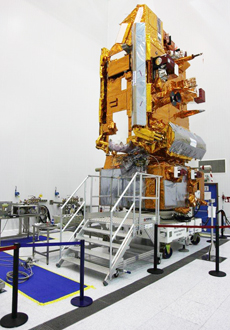

 |
 |

Fueling to begin with the Metop-B weather satellite for Starsem's next Soyuz mission from Baikonur Cosmodrome
August 20, 2012
Metop-B is positioned for its fueling in Starsem’s Hazardous Processing Facility clean room at Baikonur Cosmodrome.
The European Metop-B satellite to be orbited from Baikonur Cosmodrome on Starsem’s next Soyuz mission has been prepped for its fueling at the Kazakhstan launch site.
Metop-B is the second in a series of dedicated polar-orbiting meteorological spacecraft to be operated by EUMETSAT (European Organisation for the Exploitation of Meteorological Satellites). These platforms are procured on behalf of EUMETSAT by the European Space Agency from an Astrium-led European industrial consortium, and they include instruments delivered by the French CNES space agency, as well as the U.S. National Oceanic and Atmospheric Administration.
Fueling of Metop-B will occur in the Hazardous Processing Facility (HPF) high bay area of Starsem’s clean room facilities at Baikonur Cosmodrome. Other activity performed with the spacecraft in the HPF has included functional validations of its solar panel and integration of the satellite’s electrical batteries.
In parallel, the Fregat upper stage for Metop-B’s Soyuz vehicle is undergoing its own fueling, being performed in the Cosmodrome’s MIK 40 launch vehicle assembly and integration facility.
Liftoff of this mission is set for September, and will be the 25th commercial flight performed by Starsem.
Starsem and its Arianespace parent have played a pivotal role in the deployment of EUMETSAT satellites, which enable weather and climate-related satellite data, images and products to be provided around the clock.
After Metop-B is launched by Soyuz, it will join the nearly identical Metop-A spacecraft lofted by Starsem in October 2006 on another Soyuz mission from Baikonur Cosmodrome.
In addition to service provided by the Metop spacecraft from polar orbit, EUMETSAT also operates the Meteosat series of satellites in geostationary orbit. Its current Meteosat-8 and Meteosat-9 platforms are positioned over Europe and Africa, while Meteosat-7 is located over the Indian Ocean.
Meteosat-7 – orbited by Arianespace during 1997 from the Spaceport in French Guiana on an Ariane 4 launcher – was the final operational satellite in the Meteosat First Generation (MFG) series of observation platforms that provided reliable imaging of the full Earth disc along with data for weather forecasts during decades. Meteosat-8 and Meteosat-9 – launched by Arianespace aboard Ariane 5 vehicles from the Spaceport in August 2002 and December 2005, respectively – initiated the Meteosat Second Generation (MSG) satellite series.
They were joined by Meteosat-10, which currently is undergoing a commissioning process after being lofted in July 2012 by Arianespace on another Ariane 5 mission.
